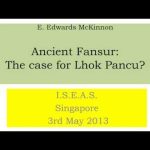“Ancient Fansur, Aceh’s ‘Atlantis'” Part 3 of 3
Part 1:
Date: Friday, 3rd May, 2013
Time: 3:30-5:00pm
Venue: Institute of Southeast Asian Studies, Seminar Room II
(30 Heng Mui Keng Terrace, Pasir Panjang, Singapore 119614)
About the Lecture
Following recent seismological and archaeological research, there is increasing evidence to suggest that the long-lost site of ancient Fansur, a toponym often associated with the Barus region, may be found in the geographically strategically located bay of Pancu, a short distance west of the modern city of Banda Aceh.
For over a century, historians have spilled much ink relating to this toponym which appears in Arab, Armenian, Chinese and Malay sources. Writing in the early 18th century, the Dutch geographer Francois Valentijn located Fansur, the birthplace of Hamzah Fansuri the Sufi poet, in the furthest northwest corner of Aceh. An archaeological site discovered at Lambaroneujid in the bay of Pancu in the 1970’s lies precisely in this location. Further evidence suggests to this writer that Pancu, not Barus, was the location of the former harbour of Fansur from which Arab seafarers obtained their camphor known as kapur Fansuri. There is no doubt that camphor came from the hinterland of modern Barus, an area known to 11th century Tamils as Varocai. Fansur was thus, in all likelihood, an entrepot, not the direct source of the resin, even though historical sources suggest that Fansur was the point of origin. There are several such misrepresentations in ancient sources.
Fansur is thought to have disappeared in the 14th century. There is increasing evidence that the disappearance of ancient Fansur was due to either a major earthquake or a tsunami or both. Recent scientific evidence suggests that a tsunami hit this northern coast of Aceh in 1390 CE. A further tsunami occurred some 60 years later, in or about 1450 CE. The Sultanate of Aceh arose in the late 15th or early 16th centuries. These events may be inter-connected. In the 17th century, a settlement on the shores of the bay of Pancu, immediately east of Aceh Head was known as Indrapurwa, a location now known as Lambaroneujid. The presentation will put forward the case for Pancu as the now-lost site of ancient Fansur.
About The Speaker
Dr. E. Edwards McKinnon is an Associate Fellow at the Institute of Southeast Asian Studies, Singapore, Nalanda Srivijaya Centre. He has received a PhD. and an M. A. from Cornell University and is a Fellow of the Royal Asiatic Society, London. A long term resident in Indonesia, he is concerned with cultural heritage management and conservation and has written on art historical and archaeological subjects relating to Sumatra, west Java and Kalimantan, in particular archaeological ceramics, Buddhist imagery in Kutei and early Islamic tombs in Aceh.
His current research interests are mediaeval south Indian relationships with Sumatra, the pre-sultanate archaeology of Aceh and arrival of Islam as well as the historical impact of seismic events in the Aceh region.
Recent presentations include “The Lamri Coast of Aceh: The Impact of Earthquakes and Tsunamis” at the EURASEAA 14 Conference in Dublin in October 2012 and “The Sejarah Melayu, The Tombstones of Lamreh and possible evidence for an Immigrant Sufi Merchant Community” at the Identities and Islam Conference at the University of Southampton, in April 2013.
Leave A Reply
You must be logged in to post a comment.









 Paranormal
Paranormal

